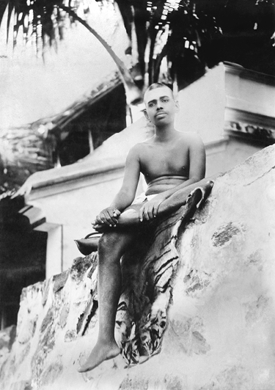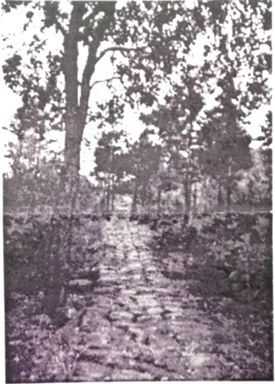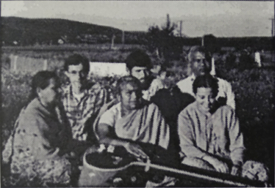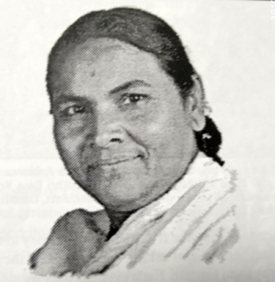The Meaning of Sri Ramanasramam
Geeta Bhatt, a devotee from New York City, interweaves the story of many pilgrims with her own, revealing the true meaning of Sri Ramanasramam and how the Maharshi continues to guide and bless seekers from the world over.
This past february I stayed at Sri Ramanasramam for a total of ten days. Not a significant time in the larger scheme of things, but significant in the sense of what happens there, or more importantly, afterwards.
My past visits to the abode of the Maharshi were filled with memorable events. Every minute of the stay was filled with observable occurrences, but this time, why wasn't I feeling anything? In fact, I was acutely aware, on the physical level, of all the noise, the crowds and the routine of life at the ashramam. I sat in the Old Hall, observed the pujas to Bhagavan's shrine, listened to the Vedas, to the Tamiḷ parayana, walked around in the Matrubhuteshwara Temple and did the giripradakshina on Mahasivaratri night. But I couldn't understand why all these activities lacked the emotional intensity that I had always experienced and now expected!
I walked around the ashramam with an inner ease and calm, but that I attributed to the familiarity of the surroundings and to the knowledge that I was accepted as an integral part of the larger Ramana family. Outwardly it appeared as if the number of visitors to the ashramam had increased tenfold since the last time I was there. There were bus loads of school children on field trips, villagers on pilgrimage, western tourists on 'check out all the ashrams' route, Hindu pilgrims, the curious and those filled with wanderlust. Why did it feel to me that there were more of these than the sincere seekers? And then it happened...
After dinner when I was walking towards the main gate there was a total blackout. All the lights went out. Not wanting to walk in the dark, I sat down in the little room used for leaving foot wear. A young lady was sitting there, and a little later an older woman joined us. We began to talk, and as the conversation progressed the real purpose of my visit started to take shape. The young woman said she was from England and of Portuguese descent. This was her second visit to India and now she had found what she was looking for - BHAGAVAN. She said, "I am probably the first Portuguese to come here. I haven't heard of any other Portuguese ever coming to Bhagavan." I told her that for the last few months I was searching for the copy of the book In Days of Great Peace, by Mouni Sadhu, a Portuguese devotee and a sadhaka, who had written this most amazing book of his sadhana under Bhagavan's watchful gaze. This book had made a profound impression on me. On my second visit to Sri Ramanasramam I read his account and was deeply moved and touched by his writing. In fact there is only one copy of his book in the library and that for "reference only". The young woman, whose name I never got, was overwhelmed by this information and said, "It's strange that I should meet you."
The older German woman, whose name is Ilse, then started to tell us that she visited the Master in the mid-1940s and had been coming to the Ashramam since then. Being of Jewish descent, she had fled Nazi Germany and was teaching in India. After hearing of Bhagavan she travelled by train to Tiruvannamalai and then took a bullock cart to the Ashramam. She said, "I was wearing a frock, and was dirty from the long journey. I felt that I should wash and change into more appropriate attire before going to see the sage. I was standing at the door of the Old Hall (that is the southern door that is now closed and leads into the Samadhi Hall) when someone urged me to go to him right away. I walked in and stood in front of the sofa, when He made the gentlest of gestures, inviting me to sit down. That is when everything disappeared. There was no sofa, no hall, no Maharshi, no me. The thought came 'There is no floor. Where can I sit?' I don't know how long I stood there, but eventually I did sit down."
In all my later conversations with Ilse, she talked about the all-pervading peace in the Ashramam of those days; she talked about the beauty and Grace of those eyes. She kept trying to describe to me Bhagavan's complexion, which she thought was most unusual: "He was light skinned, lighter than some Europeans when they have lived in the East for a long time." She fumbled for the right words, looked at my hands, her own hands and kept saying, "It was lighter than mine, it wasn't like yours, it was light. It was like... was like..." and then words failed her. Was it golden, was it a translucent quality that she was looking for? Hearing her speak I kept wondering how one describes Divine Manifestation in human terms? Yes, the form was human, but was it human? Didn't Bhagavan himself once say to a boyhood friend, "Yes, this is not the same body" when it was observed that Venkatramana's skin was rough when they were young and now it had an unusual softness to it.
I don't know what she had witnessed, but this devotee left me feeling like I saw Bhagavan in the flesh. By sharing her memory of those moments, she transported me to His physical presence. Thank you, Ilse, for giving me a glimpse of that moment, that PRESENCE!
The electricity was restored, and we parted company. The next day I saw Ilse again, but the young Portuguese devotee had moved on.
On another evening while in the Dining Hall, the person next to me asked "Do you speak English?" Leonor Cunha, as I got to know her name later, had just gotten off the bus. This was her first visit to Southern India and to Sri Ramanasramam. During the next few days, we sat in front of the bookstore, walked in and around the ashramam, and she shared her feelings and doubts with me. Leonor's spiritual quest had brought her to North India once before, and she was familiar with Sai Baba and some other sages, but nothing satisfied her yearning. Only a few days back she had read the Portuguese translation of Arthur Osborne's book and then boarded a flight for Madras, leaving behind her husband and children. From the airport she took a cab to the city bus stop and boarded a bus that dropped her at the ashramam gate. She said, "This feels like home." The need to meet and seek out other living gurus was quickly leaving her. In fact, a visit to another teacher in town, at the insistence of some other visitor, left her feeling uncomfortable. She wanted to know if it was right to decline to go to other places and teachers when asked to by fellow pilgrims. Her face betrayed the intense emotion she was feeling, and I felt privileged to witness the outpouring of Bhagavan's Grace on this sadhaka for whom all desires to be some place else were dropping away. He had chosen her; she had arrived.
A young Filipino-American from the U. S. West Coast also shared his story with me. He said he migrated to the West Coast as a teenager from the Philippines with his parents. He related the painful years he experienced in high school where he was teased for being different. He was drawn towards the martial arts, and the New Age movement. Visiting a bookstore he saw Bhagavan's face on a book cover. He said, "I went home, but couldn't get that face out of my memory. It haunted me and I even started to see His face in my sleep! I had to go back to the bookstore and buy that book. Once I read it, there was no turning back. I had to come HOME, I had to come to HIM." Saying this he turned towards the Samadhi Hall. There were tears in his eyes. I thanked him for sharing his story with me. He looked at me for a long time, and said, "I knew you would understand," and we parted.
A lady of Irish descent who lives in London comes to the ashramam every winter for three months. She loves everything about India. One morning after completing the inner pradakshina, we were sitting and taking breakfast in town when she started to tell me how she came to Bhagavan.
"I am not the sentimental type," she said, "but I have been drawn to matters spiritual for a long time. In London some friends introduced me to Hinduism, and after some months of bhajans and pujas, I had had enough. Then I came on a sight-seeing tour of South India. We visited every temple and palace. By the time we reached Tiruvannamalai I had seen it all, heard it all. I was up to here (indicating over her head) with it, and was no longer interested. That evening we were to visit Sri Ramanasramam. I came reluctantly, because one more lecture on Advaita, one more puja and I was ready to throw up.
"We walked into the Samadhi Hall, and the life-size picture of Bhagavan was in front of me. I saw nothing but those eyes... that face. I knew that was the face of GOD. That is it, this is my story."
A bright smiling face, a face full of life and love, is how I will always remember her.
There were many more that I spoke to, or observed. There was the young girl from Australia, the woman from Texas, the couple from Bangalore and the young woman from Japan that I got to know. All seekers, all drawn to the abode of the Sage of Arunachala, all on their own inner journeys, guided by the Maharshi. All individuals, but still part of the larger crowd of humanity that daily visits the ashramam. Only on reflection it is becoming clearer to me what the real purpose is of the crowd and activities at Sri Ramanasramam. At times we see only the throngs and the crowd, we hear the traffic, the peacocks and monkeys, and miss the Silence and Grace that guides the sincere seekers. Even during Bhagavan's time the guidance and grace worked unnoticed and unhindered by the outer activities of daily living. Today, it seems the crowds are there to hide the individual, mass pujas are a cover for the individual surrender. The magic of the Maharshi goes on unobserved by the casual visitor. For those not yet devoured by Arunachala, Sri Ramanasramam is just another overcrowded holy place, once an abode of a Sage and nothing more. But for those who sing
Abandoning the outer world, with mind and breath controlled, to meditate on Thee within, the Yogi sees Thy Light, O Arunachala! and finds his delight in Thee.
There are no crowds, no noise, no distraction, just the peace and presence.Because you give precedence to worldly things, God appears to have receded to the background. If you give up all else and seek Him alone,
He alone will remain as the I, the Self. "Sadhana and Grace,"
The Greening of Arunachala
Visitors to Sri Ramanasramam are definitely seeing a change. The once barren slopes of the holy Arunachala Hill are now pushing up trees, shrubs, herbs and grasses from its dry, rocky surface. Will the ecology of this sacred hill ever return to the days when it sheltered numerous birds, mammals, provided medicinal herbs to the infirm, cool shelter to the weary and edible plants to the hungry? If the Annamalai Reforestation Society (ARS) succeeds in their determined drive to balance this ecology with the growing population of Tiruvannamalai it most certainly will.
Responding to a desperate situation facing the holy Arunachala Hill, the Annamalai Reforestation Society was established in 1988. It is well known that Sri Ramana Maharshi loved this mountain and looked upon it as God Itself. He was most happy when roaming upon Its slopes. Aware of this, many prominent devotees have taken active interest in establishing the ARS and working to achieve its goals. The aims of this voluntary, nonprofit organization are to work towards the reforestation and conservation of Arunachala and to encourage local, national and international participation in the regeneration and protection of animal, bird and plant life in surrounding areas through awareness campaigns, educational activities and employment opportunities.
If we are to mention a few of the society's accomplishments during the last ten years we must first describe how acres of waste land within the Arunachaleshwara Temple are now a lush beautiful garden of flowering plants, fruit trees and scared trees of medicinal and herbal values. The tens of thousands of tree saplings growing there are used to reforest the hill, the giriprakshina road and the temple lands around the hill. The nursery also maintains adequate stock to offer saplings to local schools, individuals and other organizations.
Eight acres of land near Tiruvannamalai, which was previously a barren stretch full of boulders and rocks, was acquired by ARS in 1992. The has become the model permacultural farm in India, and harnesses non-conventional energy resources, like bio-gas and solar heat for power generation.
ARS also runs classes for children in nearby villages to create awareness and also to teach ecofriendly life-style choices.
The work is impressive on many levels. All repeat visitors to Arunachala are aware of the return of vegetation on the hill, which is the direct result of the untiring efforts of ARS. The Society employs many women. The workers are trained, enthusiastic, knowledgeable, and dedicated to their cause.
Recent pilgrims to Arunachala cannot but notice the shady path to Skandasramam and the new abundant growth of trees and flowers on the Hill.
During the last five years major funding for this work came from the Australian International Development Assistance Bureau. This funding runs out in mid 1998. The current interest from the corpus fund meets 35% of the expenses and income from the farm and nursery covers 30%. To continue the work at the present level, with no expansion, the project urgently needs to increase its corpus fund.
Individuals who want more information, wish to become members, or desire to send donations can write directly to:
60-B/1 R.O.A. Colony
Sri Ramanasramam P.O.
Tiruvannamalai 606603
Tamiḷ Nadu, INDIA
A Dream Comes True
The following abridged article was written by Evelyn Kaselow Saphier in 1972. This year marks the 25th anniversary of the founding of Arunachala Ashram in Nova Scotia, Canada.
In the heart of New York City's Lower East Side on Sixth Street near First Avenue there is a small rented storefront meditation center known as Arunachala Ashram, Bhagavan Sri Ramana Maharshi Center. Over the years many seekers have come to this Ashram, joined the regular practice of prayer and meditation, and then moved on to different pursuits. But Arunachala Bhakta Bhagawat has continued his spiritual practice in Arunachala Ashram with or without companions all these years, knowing that disappointments come only to make us strong and fit for the future.
The history of this Center is the life-story of Arunachala Bhakta Bhagawat, the man who sits faithfully on the Ashram floor chanting and singing devotional hymns every night, as he has done since December 7, 1966. He was the man inspired and inebriated with his dream of building a residential ashrama in the open-air surroundings "where people from Wall Street can sit on the grass." Also, he dreamed of building a temple on Fifth Avenue in New York City in honor of the great sage of modern India, Bhagavan Sri Ramana Maharshi.
In the fall of 1970, a young couple from New Jersey, Joan and Matthew Greenblatt, each only 19-years-old, walked in through the New York Ashram door and fell into the nightly spiritual practice with devotional fervor. Until then, the couple had no idea of the future awaiting them. Nor until then did they feel an inner awakening which filled their lives and turned their minds inward to the source of joy, which was to be the mainstay in their new life. Drawn by the practice of nightly recitation, chanting and sitting in silence, as well as the warm and simple devotional nature of their new friend, Arunachala Bhakta Bhagawat, Joan and Matthew would come again and again until their normal life and the life of service to the Ashram merged.
In the autumn of 1971, an offer came for the gift of a small farm in Nova Scotia Canada. Without a second's thought, the Greenblatts became the instrument of Divine Grace in Bhagawat's life. Within twelve hours, the young couple was driving north in pursuit of land for a residential ashrama. They drove straight to the intending-donor's home near Halifax, Nova Scotia, only to discover that his enthusiasm had meanwhile waned.
Encouraged by the friendliness of all they met, they went from door to door asking the residents if they knew about any farm for sale. Each evening they would return from their search to the home of a kind, elderly couple, the Taylors of Clarence (Nova Scotia). As the search continued, the feeling began to grow on the young couple that the farm house where they returned in the evenings for warm food and conversation would be their own home! The Taylors had been planning to sell their farm and return to town.
This is how Joan and Matthew, with hardly any money, made a token down payment on the farm of 130 acres at the foot of the northern mountain range in the peaceful Annapolis Valley of Nova Scotia.
Soon after, the work of fund-raising was undertaken. The Greenblatts begged and borrowed from every person they knew and also those they did not know, but it was only shortly before their return to Nova Scotia that their efforts bore fruit. After they arrived in Nova Scotia the work began with exuberance for converting the farm into a residential Ashram for all devotees of Bhagavan Sri Ramana Maharshi. From the end of April, 1972, the young couple and a friend and fellow devotee, Dennis J. Hartel of Tonawanda, New York State, started working full time to make the farm a home for all aspirants and children of the Universal Spirit who came to its door.
The country Ashram is dedicated to the simple life of hard work, the practice of Sri Ramana Maharshi's teaching of Self-Enquiry of "WHO AM I?" and total surrender to the Divine Presence. Every evening at seven and morning before dawn, Sanskrit hymns and chants resound with the sweetness that comes directly from the Heart. This is followed by silence, then by the reading of teachings. The doors of the Ashram' both in New York City and Nova Scotia, are always open to all.
We offer our infinite gratitude for the blessings showered upon our bodies and minds in this lifetime. All praises be to Life Universal in the form of Bhagavan Sri Ramana Maharshi, who by Divine Grace has brought the dream of a man from the backwoods of India, Arunachala Bhakta Bhagawat, to fruition.Remembering Yogamaya Bharati Singh
We are very sad to report the passing of Yogamaya Bharati Singh in the early hours of Thursday, May 8. She was the devoted wife of Arunachala Bhakta Bhagawat, the founder of our Ashram.
Born in the village of Rusulpur, Bihar in 1922, and following the practice of those times, Yogamayaji was married at a young age. In 1947, her husband traveled to the USA for graduate studies and later took a post with the India Embassy in Washington, D. C. Yogamayaji was unable to join her husband until 1952. It was here that she gave birth to her first son Bhaskar (a second son, Prabhakar, died as an infant in India in 1962). She was residing with her son in Forest Hills, New York City when she died.
Yogamayaji assisted her husband in the founding of Arunachala Ashram and serving visitors and devotees. Though living in the West for over forty years she was totally untouched by the extravagances of the American culture, always remaining a simple and pure villager, performing the traditional practices passed down to her through an ancient and rich culture.
In her last days she demonstrated more vigor and strength than in previous years. Her sudden demise surprised all, except, perhaps, Yogamayaji herself. The night of her passing she told her daughter-in-law (Hena) that she would shortly leave for the other world. No one actually believed her, but as the night progressed into early morning her physical strength drastically waned. She asked her daughter-in-law to forgive her for any trouble she may have caused. She lay on her bed, raised her joined palms upward and over her head, repeated Bhagavan's name and was absorbed in Him. At that moment she was lifted into the padmasana posture, as is the custom in her village.
Yogamayaji's simple and noble life, and her act of leaving this life, will always be remembered by her friends and the devotees of Arunachala Ashram.
Devotion and Meditation
A devotee referred to the contents of the 6th verse of "Upadesa Saram" (chittajam japa dhyanam uttaman etc.). Fully translated, this verse reads: "The repetition aloud of His name is better than praise. Better still is its faint murmur. But the best is repetition within the mind-and that is meditation, above referred to."
Bhagavan explained: "At the initial stage to develop bhakti (devotion), mantras should be repeated aloud and only by such constant practice control of mind can be acquired. It will be felt difficult to control the mind and do meditation at the initial stage. Hence utterance of mantras aloud can be successfully accomplished at the beginning stage. For a novice silent concentration cannot be achieved easily unless he has past merits (purva-punya) to his credit.
"Sri Tukaram and other great saints used to tie salangai (small bells) around their legs and hands and do bhajana, dancing and jumping with ecstasy throughout the night. But during day time they would remain in samadhi. Likewise without allowing sleep to overcome and devour our time the mind should be concentrated on Ishvara (God).
"In the later stage vichara (Self-enquiry) becomes very easy and itself includes all, i.e., sravana, manana and nidhidhyāsana - hearing, reflection and uninterrupted contemplation."
Letters and Comments
The Kindest and Most Powerful Energy of the Universe
Thank you for your very kind and most generous response to my letter. I'm very grateful for the photos and am searching now for suitable frames for them. Just glancing at the Maharshi's picture brings a measure of peace. As Sri Ramakrishna Madhavpeddi wrote, his eyes "are the kindest and most powerful energy of the universe." I can really feel the kindness. At the same time, I become immediately aware of my shortcomings, and so it's a little difficult to look!
Thank you for the newsletters and the booklet, Who Am I?. Simply reading the teachings is a practice, isn't it?
Thank you also for your invitation to attend the celebration of the ashrama's twenty-fifth anniversary and the Maharshi's 101st anniversary (of his Advent at Arunachala). Jean-Rene and I regret that we cannot make it to the ashrama at that time, but hope to visit one day.
I had always pronounced the word "A-RUN-a-CHA-la." How much more beautiful is its true pronunciation!
We've lent our video [The Sage of Arunachala] to the Yasodhara Ashram, which is across the lake from us. The residents and students there follow the teachings of Swami Sivananda Radha, who died in the fall of 1995. At the behest of Swami Radha, the permanent residents take an Aikido class with us once a week. That may seem like a hodgepodge of traditions, but the different teachings don't contradict one another.
Thank you again, for your great kindness. If you are ever in this area, please come stay with us.
British Columbia, Canada







The Power of Prayer
I became very ill and one evening was in such pain that I could not find the least respite and could not go to sleep. I dragged myself from my futon to the phone and telephoned my doctor, but he had not yet returned to Tokyo from his trip to Europe, and I had none of the necessary medicines. I returned to bed and finally in acute pain burst into tears of exhaustion and despair. Then I recalled your issue of The Mountain Path on the power of prayer [April 1966, pg.152 - Editor]. I seldom pray because there is little that I want apart from what I am striving for all the time. But I decided to pray to Bhagavan. I pulled myself together and threw myself with all my heart upon his mercy and asked for he]p. Immediately, without any time lapse, an extraordinary thing happened. All my energies, my thoughts, my emotions were suddenly sucked into my heart. It was like a sort of spiritual vacuum cleaner! They seemed to be sucked into what I thought of as a vanishing point in the heart. Although it all happened in a flash, I have grown accustomed through introspection to observe things of an inner nature, and I was aware that what I have called a 'vanishing point' was something like the entrance to the Great Void, to a realm of objectless infinity of tremendous power, speed and purpose, and of infinite good will. In words all this sounds so miserably incomplete. Anyway, when I seemed to be poised on the brink of this Void, suddenly into my conscious mind popped, like a menu card, a clear list of things which I myself could do in the house that minute to alleviate my extremity.
I crawled out of bed again and after about an hour of following this advice was able to fall asleep. The next morning my doctor had returned to Tokyo and was able to send me all I needed.
From The Mountain Path






